
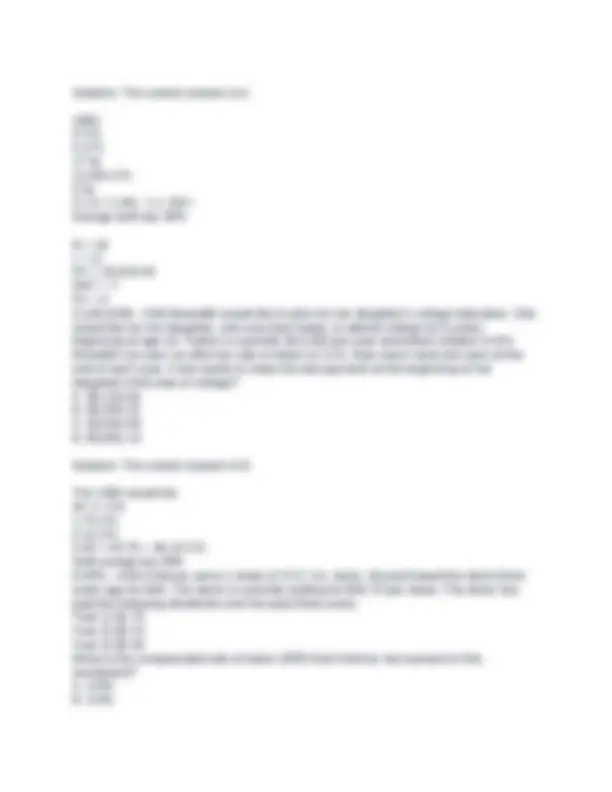
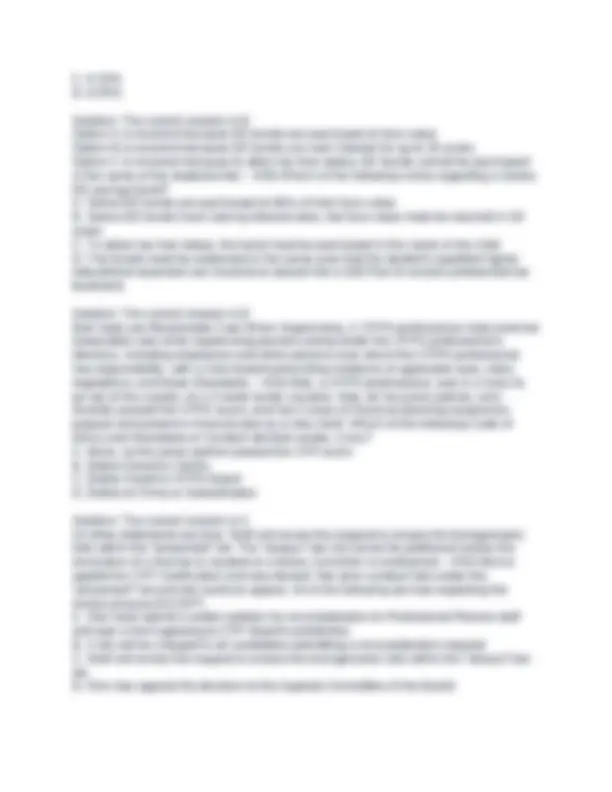
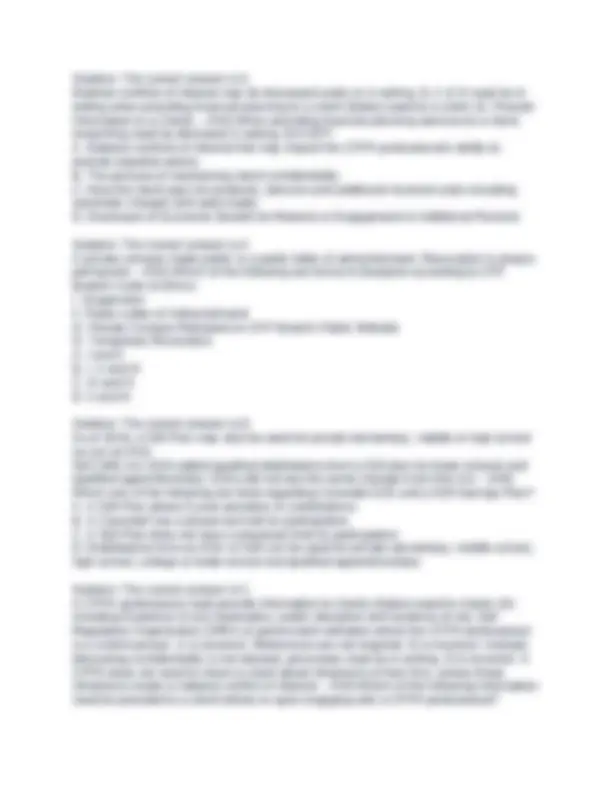
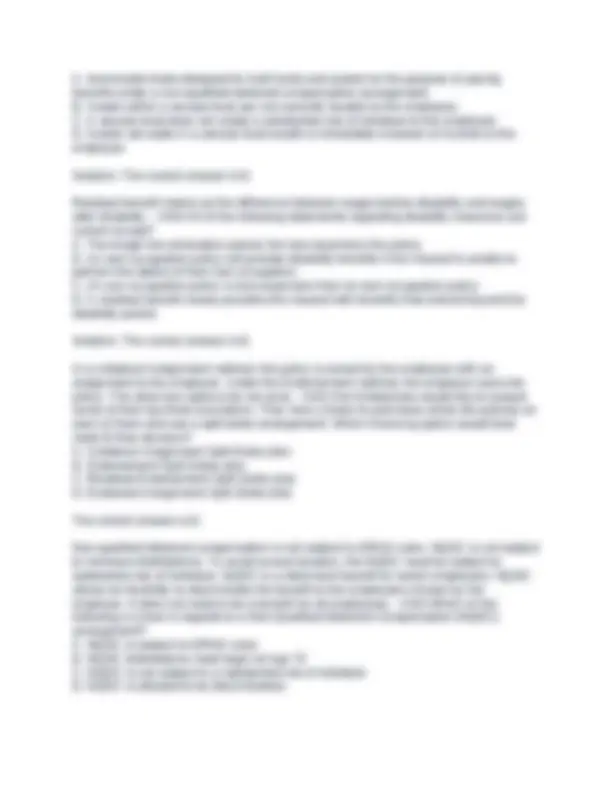
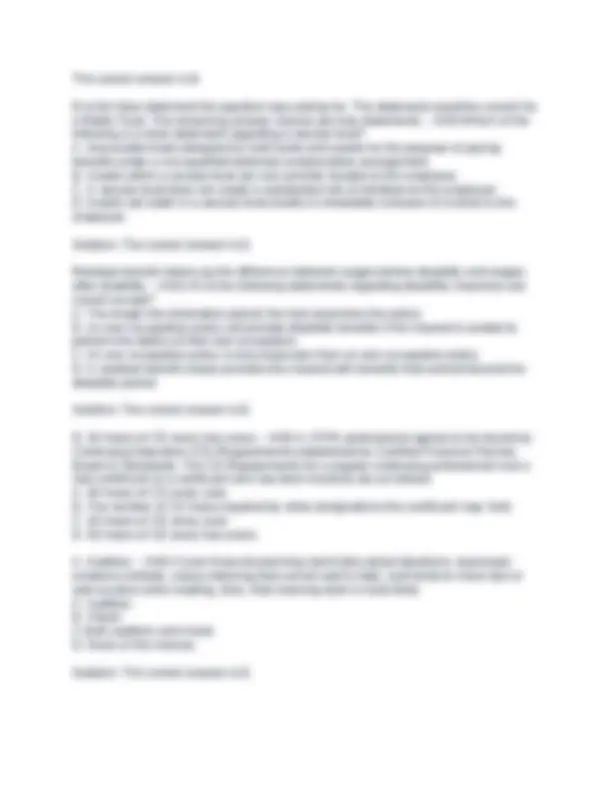
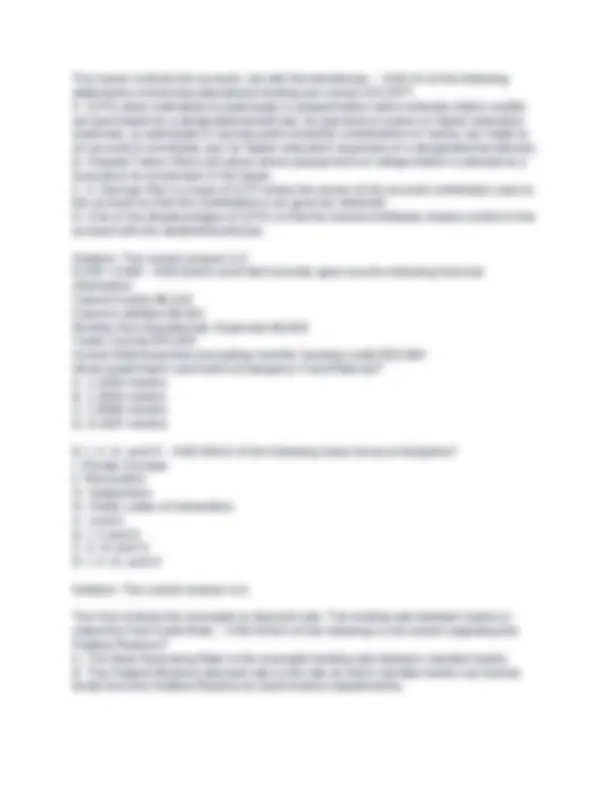
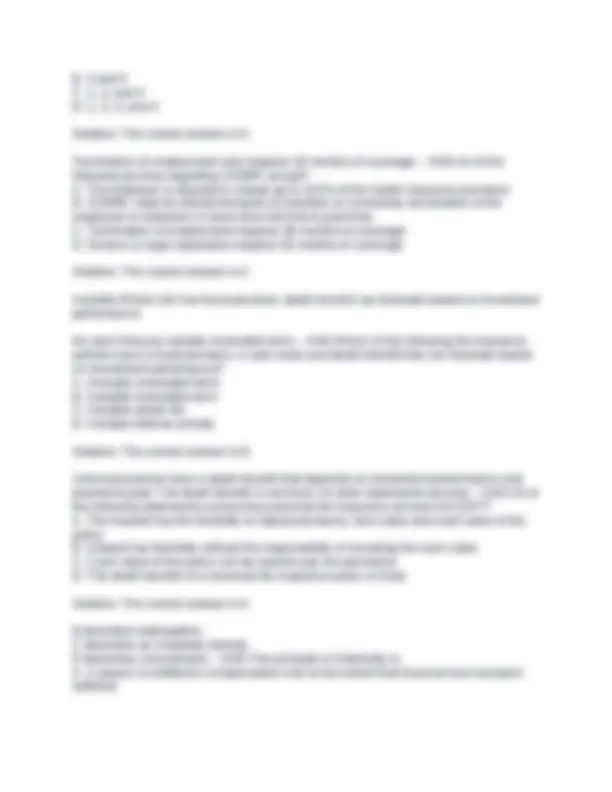
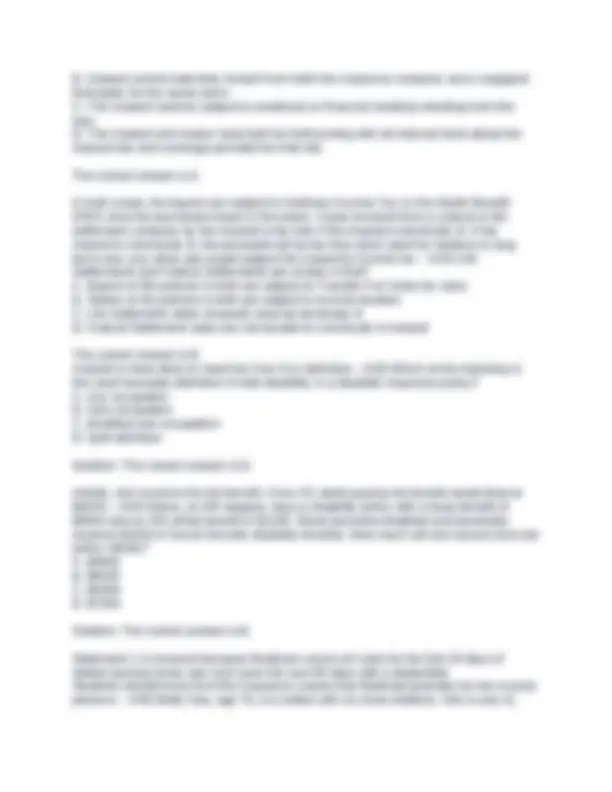



Study with the several resources on Docsity

Earn points by helping other students or get them with a premium plan


Prepare for your exams
Study with the several resources on Docsity

Earn points to download
Earn points by helping other students or get them with a premium plan
Community
Ask the community for help and clear up your study doubts
Discover the best universities in your country according to Docsity users
Free resources
Download our free guides on studying techniques, anxiety management strategies, and thesis advice from Docsity tutors
CFP Financial Planning and Insurance Exam-Graded A
Typology: Exams
1 / 17

This page cannot be seen from the preview
Don't miss anything!










Current Ratio = Current Assets/Current Liabilities = 680,000/490,000 = 1.3878 - ANS- On December 31, the Gold Standard Company reported the following information on its financial statements: A. Total current assets $680, B. Total long-term assets $1,850, C. Total current liabilities $490, D. Total long-term debt $975, According to this information, the company's current ratio is approximately Solution: The correct answer is D. Will = American Opportunity= $2, 2,000 × 100% = 2, 2,000 × 25% = 500 Sydney = American Opportunity = $2, 2,000 × 100% = 2, 2,000 × 25% = 500 - ANS-Will is a freshman at Florida State University where his tuition is $4,000. Sydney, his older sister, is a junior at Expensive University, where tuition is $25,000. What is the maximum tax credit Will and Sydney's parents can take? A. $2, B. $3, C. $4, D. $5, Solution: The correct answer is D. Coverdell and 529 Plans can be used for private elementary, middle, or high school (as of TCJA 2017). A Coverdell does have phase-out limits, a 529 does not. - ANS-What is one of the primary differences between a Coverdell ESA and a 529 Savings Plan is true? A. Coverdell can be used for private elementary, middle or high school, a 529 cannot. B. A Coverdell does not have a phase-out limit for participation, 529 does have a phase- out limit for participation. C. Both A & B D. Neither A nor B Solution: The correct answer is B. The American Opportunity credit now includes course materials. American Opportunity is per student, lifetime is per family. - ANS-All of the following statements are true, except?
A. The American Opportunity credit is available for the first four years of a degree program or certificate. B. The American Opportunity credit does not include course materials. C. The American Opportunity credit is awarded on a per student basis. D. The Lifetime Learning credit is awarded on a per family basis. Solution: The correct answer is C. Option A is not the best answer because UTMA account is not tax efficient. Since their son is 11, kiddie tax rules will apply. Option B is not the best answer because a Coverdell Education Savings Account has a contribution limit of $2,000. Option C is correct. The 529 Plan allows higher contributions and provides tax-free distributions for qualified education expenses. Option D is not the best answer because Traditional IRAs do not allow loans. - ANS-David and Mary are concerned because they have not saved for their son's college education. They are both 35 years old and their son is 11 years old. Their combined income is $100,000 and they want to begin saving $5,000 per year in a tax efficient manner. Which of the following is the best investment choice for David and Mary? A. UGMA/UTMA B. Coverdell Education Savings Account C. 529 Plan D. Loans from the parents' Traditional IRAs Solution: The correct answer is B. American Opportunity is good for four years of post-secondary education. Lifetime is available throughout your lifetime. American Opportunity is per student, lifetime is per family. - ANS-All of the following statements are true, except? A. The American Opportunity credit is only available for four years of post-secondary education. B. The Lifetime Learning credit is only available for the first two years of post-secondary education. C. The American Opportunity credit is awarded on a per student basis. D. The Lifetime Learning credit is awarded on a per family basis. Solution: The correct answer is D. 10BII N = 30 x 12I = 5 / 12PV = 400,000PMT = ?FV = 0 1 INPUT 5, orange shift key AMORT, =, = 8,313.22 - ANS-Emily recently purchased a house for $430,000. She made a down payment of $30,000 and financed the balance over 30 years at 5%. If Emily's first payment is due on August 1st of the current year, how much interest will she pay in the current year? A. $2,423. B. $5,885. C. $3,288. D. $8,313.
Solution: The correct answer is D. Option A is incorrect because EE bonds are purchased at face value. Option B is incorrect because EE bonds can earn interest for up to 30 years. Option C is incorrect because to attain tax-free status, EE bonds cannot be purchased in the name of the student/child. - ANS-Which of the following is true regarding a Series EE savings bond? A. Series EE bonds are purchased at 80% of their face value. B. Series EE bonds have varying interest rates, but face value must be reached in 30 years. C. To attain tax-free status, the bond must be purchased in the name of the child. D. The bonds must be redeemed in the same year that the student's qualified higher educational expenses are incurred or placed into a 529 Plan to receive preferential tax treatment. Solution: The correct answer is D. Bob must use Reasonable Care When Supervising. A CFP® professional must exercise reasonable care when supervising persons acting under the CFP® professional's direction, including employees and other persons over whom the CFP® professional has responsibility, with a view toward preventing violations of applicable laws, rules, regulations, and these Standards. - ANS-Bob, a CFP® professional, was in a hurry to go out of the country on a 3 week family vacation. Bob, let his junior partner, who recently passed the CFP® exam, and has 2 years of financial planning experience, prepare and present a financial plan to a new client. Which of the following Code of Ethics and Standards of Conduct did Bob violate, if any? A. None, as the junior partner passed the CFP exam. B. Duties Owed to Clients C. Duties Owed to CFP® Board D. Duties to Firms or Subordinates Solution: The correct answer is C. All other statements are true. Staff will review the request to ensure the transgression falls within the "presumed" list. The "always" bar list cannot be petitioned unless the revocation of a license is vacated or a felony conviction is overturned. - ANS-Becca applied for CFP Certification and was denied. Her prior conduct falls under the "presumed" list and she wants to appeal. All of the following are true regarding the review process EXCEPT: A. She must submit a written petition for reconsideration to Professional Review staff and sign a form agreeing to CFP Board's jurisdiction. B. A fee will be charged to all candidates submitting a reconsideration request. C. Staff will review the request to ensure the transgression falls within the "always" bar list. D. She may appeal this decision to the Appeals Committee of the Board.
Solution: The correct answer is A. Material conflicts of interest may be discussed orally or in writing. B, C & D must be in writing when providing financial planning to a client (Duties owed to a client 10, Provide Information to a Client). - ANS-When providing financial planning services to a client, everything must be disclosed in writing, EXCEPT: A. Material conflicts of interest that may impact the CFP® professional's ability to provide impartial advice. B. The process of maintaining client confidentiality. C. How the client pays for products, services and additional incurred costs including surrender charges and sales loads. D. Disclosure of Economic Benefit for Referral or Engagement of Additional Persons. Solution: The correct answer is A. A private censure made public is a public letter of admonishment. Revocation is always permanent. - ANS-Which of the following are forms of discipline according to CFP Board's Code of Ethics: I. Suspension II. Public Letter of Admonishment III. Private Censure Released on CFP Board's Public Website IV. Temporary Revocation A. I and II B. I, II and IV C. III and IV D. II and III Solution: The correct answer is D. As of 2018, a 529 Plan may also be used for private elementary, middle or high school as can an ESA. SECURE Act 2019 added qualified distributions from a 529 plan for trade schools and qualified apprenticeships. ESAs did not see the same changes from this Act. - ANS- Which one of the following are false regarding Coverdell ESA and a 529 Savings Plan? A. A 529 Plan allows 5-year proration of contributions. B. A Coverdell has a phase-out limit for participation. C. A 529 Plan does not have a phaseout limit for participation. D. Distributions from an ESA or 529 can be used for private elementary, middle school, high school, college or trade school and qualified apprenticeships. Solution: The correct answer is C. A CFP® professional must provide information to clients (Duties owed to clients 10) including Existence of any bankruptcy, public discipline and locations of any Self Regulatory Organization (SRO) or government websites where the CFP® professional is a control person. A is incorrect. References are not required. B is incorrect. Verbally discussing confidentiality is not allowed, processes must be in writing. D is incorrect. A CFP® does not need to inform a client about infractions of their firm, unless those infractions create a material conflict of interest. - ANS-Which of the following information must be provided to a client before or upon engaging with a CFP® professional?
The viatical company must report the gain as ordinary income. The amount of the viatical settlement plus the additional premiums are costs and are deducted from the proceeds in determining the gain. $300,000 death benefit - $210,000 purchase price - $9,000 premiums paid = $81,000 - ANS-A viatical settlement company purchased a $300,000 policy for $210,000 from a chronically ill individual. It paid additional premiums of $9,000 over the three years prior to the insured death. What income must the viatical company report from the policy proceeds in the year of the insured's death? A. $ B. $81,000 ordinary income C. $81,000 capital gains D. $90,000 ordinary income he correct answer is B. In a collateral Assignment method, the policy is owned by the employee with an assignment to the employer. Under the Endorsement method, the employer owns the policy. The other two options do not exist. - ANS-Owl Enterprises would like to reward some of their top three executives. They have chosen to purchase whole life policies on each of them and use a split dollar arrangement. Which financing option would best meet fit their decision? A. Collateral Assignment Split Dollar plan B. Endorsement Split Dollar plan C. Residual Endorsement Split Dollar plan D. Endorsed Assignment Split Dollar plan The correct answer is D. Non-qualified deferred compensation is not subject to ERISA rules. NQDC is not subject to minimum distributions. To avoid annual taxation, the NQDC must be subject to substantial risk of forfeiture. NQDC is a retirement benefit for select employees. NQDC allows for flexibility to discriminate the benefit to the employees chosen by the employer. It does not need to be a benefit for all employees. - ANS-Which of the following is a true in regards to a Non-Qualified Deferred Compensation (NQDC) arrangement? A. NQDC is subject to ERISA rules B. NQDC distributions must begin at Age 72 C. NQDC is not subject to a substantial risk of forfeiture D. NQDC is allowed to be discriminatory The correct answer is B. B is the false statement the question was asking for. The statement would be correct for a Rabbi Trust. The remaining answer choices are true statements. - ANS-Which of the following is a false statement regarding a secular trust?
A. Irrevocable trusts designed to hold funds and assets for the purpose of paying benefits under a non-qualified deferred compensation arrangement. B. Assets within a secular trust are not currently taxable to the employee. C. A secular trust does not create a substantial risk of forfeiture to the employee. D. Assets set aside in a secular trust results in immediate inclusion of income to the employee. Solution: The correct answer is D. Residual benefit makes up the difference between wages before disability and wages after disability. - ANS-All of the following statements regarding disability insurance are correct except? A. The longer the elimination period, the less expensive the policy. B. An own occupation policy will provide disability benefits if the insured is unable to perform the duties of their own occupation. C. An any occupation policy is less expensive than an own occupation policy. D. A residual benefit clause provides the insured with benefits that extend beyond the disability period. Solution: The correct answer is B. In a collateral Assignment method, the policy is owned by the employee with an assignment to the employer. Under the Endorsement method, the employer owns the policy. The other two options do not exist. - ANS-Owl Enterprises would like to reward some of their top three executives. They have chosen to purchase whole life policies on each of them and use a split dollar arrangement. Which financing option would best meet fit their decision? A. Collateral Assignment Split Dollar plan B. Endorsement Split Dollar plan C. Residual Endorsement Split Dollar plan D. Endorsed Assignment Split Dollar plan The correct answer is D. Non-qualified deferred compensation is not subject to ERISA rules. NQDC is not subject to minimum distributions. To avoid annual taxation, the NQDC must be subject to substantial risk of forfeiture. NQDC is a retirement benefit for select employees. NQDC allows for flexibility to discriminate the benefit to the employees chosen by the employer. It does not need to be a benefit for all employees. - ANS-Which of the following is a true in regards to a Non-Qualified Deferred Compensation (NQDC) arrangement? A. NQDC is subject to ERISA rules B. NQDC distributions must begin at Age 72 C. NQDC is not subject to a substantial risk of forfeiture D. NQDC is allowed to be discriminatory
The owner controls the account, not with the beneficiary. - ANS-All of the following statements concerning educational funding are correct EXCEPT: A. QTPs allow individuals to participate in prepaid tuition plans whereby tuition credits are purchased for a designated beneficiary for payment or waiver of higher education expenses, or participate in savings plans whereby contributions of money are made to an account to eventually pay for higher education expenses of a designated beneficiary. B. Prepaid Tuition Plans are plans where prepayment of college tuition is allowed at a fixed price for enrollment in the future. C. A Savings Plan is a type of QTP where the owner of the account contributes cash to the account so that the contributions can grow tax deferred. D. One of the disadvantages of QTPs is that the owner/contributor shares control of the account with the student/beneficiary. Solution: The correct answer is C. 9,243 / 4,693 - ANS-Darrin and Kathi recently gave you the following financial information. Current Assets $9, Current Liabilities $6, Monthly Non-discretionary Expenses $4, Yearly Income $70, Annual Debt Expenses (excluding monthly housing costs) $22, What would Darrin and Kathi's Emergency Fund Ratio be? A. 1.2430 months B. 1.3355 months C. 1.9695 months D. 3.1697 months D. I, II, III, and IV - ANS-Which of the following is/are forms of discipline? I. Private Censure II. Revocation III. Suspension IV. Public Letter of Admonition A. I and II B. I, II and III C. II, III and IV D. I, II, III, and IV Solution: The correct answer is A. The Fed controls the overnight or discount rate. The lending rate between banks is called the Fed Funds Rate. - ANS-Which of the following is not correct regarding the Federal Reserve? A. The Bank Borrowing Rate is the overnight lending rate between member banks. B. The Federal Reserve discount rate is the rate at which member banks can borrow funds from the Federal Reserve to meet reserve requirements.
C. The reserve requirement for a member bank of the Federal Reserve is the percent of deposit liabilities that must be held in reserve. D. Open market operations is the process by which the Federal Reserve purchases and sells government securities in the open market. Solution: The correct answer is D. (8,000 + 4,000 + 2,500)/80,000 = 18% - ANS-Holly's salary is $80,000 per year. She contributes 10% of her salary to her 401(k) plan. Her employer contributes 5% of her salary to a profit share plan. She also contributes $2,500 per year to an IRA. Holly's savings ratio is? A. 5%. B. 10%. C. 15%. D. 18%. Solution: The correct answer is A. B describes subrogation. C describes an insurable interest D describes concealment - ANS-The principle of indemnity suggests that: A. A person is entitled to compensation only to the extent that financial loss has been suffered B. Insured cannot indemnify himself from both the insurance company and a negligent third party for the same claim C. The insured must be subject to emotional or financial hardship resulting from the loss D. The insured and insurer must both be forthcoming with all relevant facts about the insured risk and coverage provided for that risk Solution: The correct answer is B. Peril is proximate cause of a loss. Hazard is a condition that creates or increases the likelihood of a loss occurring. - ANS- Which of the following is correct regarding a peril and hazard? A. A hazard is the proximate or actual cause of a loss B. A peril is the proximate or actual cause of a loss C. A peril is the condition that creates or increases the likelihood of a loss occurring D. None of the above Solution: The correct answer is B. The insurance company can collect against a negligent third party, after paying the claim. - ANS-The subrogation clause means that: A. A person is entitled to compensation only to the extent that financial loss has been suffered B. Insured cannot indemnify himself from both the insurance company and a negligent third party for the same claim C. The insured must be subject to emotional or financial hardship resulting from the loss
B. 3 and 4 C. 1, 2, and 3 D. 1, 2, 3, and 4 Solution: The correct answer is C. Termination of employment only requires 18 months of coverage. - ANS-All of the following are true regarding COBRA except? A. The employer is allowed to charge up to 102% of the health insurance premium. B. COBRA must be offered because of voluntary or involuntary termination of the employee or reduction in hours from full time to part time. C. Termination of employment requires 36 months of coverage. D. Divorce or legal separation requires 36 months of coverage. Solution: The correct answer is C. Variable Whole Life has fixed premium, death benefit can fluctuate based on investment performance. No such thing as variable renewable term. - ANS-Which of the following life insurance policies have a fixed premium, a cash value and death benefit that can fluctuate based on investment performance? A. Annually renewable term B. Variable renewable term C. Variable whole life D. Variable lifetime annuity Solution: The correct answer is D. Universal policies have a death benefit that depends on investment performance and premiums paid. The death benefit is not fixed. All other statements are true. - ANS-All of the following statements concerning universal life insurance are true EXCEPT? A. The insured has the flexibility to adjust premiums, face value and cash value of the policy. B. Insured has flexibility without the responsibility of investing the cash value. C. Cash value of the policy can be used to pay the premiums. D. The death benefit of a universal life insurance policy is fixed. Solution: The correct answer is A. B describes subrogation. C describes an insurable interest. D describes concealment. - ANS-The principle of indemnity is: A. A person is entitled to compensation only to the extent that financial loss has been suffered.
B. Insured cannot indemnify himself from both the insurance company and a negligent third party for the same claim. C. The insured must be subject to emotional or financial hardship resulting from the loss. D. The insured and insurer must both be forthcoming with all relevant facts about the insured risk and coverage provided for that risk. The correct answer is A. In both cases, the buyers are subject to Ordinary Income Tax on the Death Benefit (FMV) less the purchasers basis in the policy. Value received from a viatical or life settlement company by the insured is tax-free if the insured is terminally ill. If the insured is chronically ill, the proceeds will be tax-free when used for medical or long term care, any other use would subject the insured to income tax. - ANS-Life Settlements and Viatical Settlements are similar in that? A. Buyers of life policies in both are subject to Transfer For Value tax rules B. Sellers of life policies in both are subject to income taxation C. Life Settlement seller (insured) must be terminally ill D. Viatical Settlement sales are not taxable to chronically ill insured The correct answer is B. Insured is more likely to meet the Own Occ definition - ANS-Which of the following is the most favorable definition of total disability in a disability insurance policy? A. Any occupation B. Own occupation C. Modified own occupation D. Split definition Solution: The correct answer is D. Initially, she receives the full benefit. Once SS starts paying her benefit would drop to $6200. - ANS-Diane, an ER surgeon, buys a disability policy with a base benefit of $6000 and an SIS offset benefit of $1200. Diane becomes disabled and eventually receives $1000 in Social Security disability benefits. How much will she receive from her policy initially? A. $ B. $ C. $ D. $ Solution: The correct answer is B. Statement 1 is incorrect because Medicare covers all costs for the first 20 days of skilled nursing home care and cover the next 80 days with a deductible. Students should know from the Insurance course that Medicaid provides for low income persons. - ANS-Betty Sue, age 75, is a widow with no close relatives. She is very ill,
C. Coverage C D. Coverage D E. Coverage E F. Coverage F Solution: The correct answer is B. Liability and Medical Payments Coverage is identical in all HO policies. - ANS-Which of the following offers identical coverage for all forms of a homeowners insurance policy? A. Section I B. Section II Solution: The correct answer is D. D is coverage under comprehensive. - ANS-All of the following statements are correct regarding a Personal Auto Policy Part D (Coverage for Damage to Your Auto) coverage except? A. Collision means with other vehicles B. Comprehensive covers fire, theft, or vandalism C. Collision covers damages to a borrowed or rented vehicle D. Collision covers contact with an animal or bird Solution: The correct answer is F. - ANS-Match the following scenarios to the correct coverage. Insured takes friend to emergency room after they slip on sidewalk. A. Coverage A B. Coverage B C. Coverage C D. Coverage D E. Coverage E F. Coverage F Solution: The correct answer is E. - ANS-Match the following scenarios to the correct coverage. Insured is sued because their deck collapsed during a party. A. Coverage A B. Coverage B C. Coverage C D. Coverage D E. Coverage E F. Coverage F Solution: The correct answer is B. A, C and D are in section I - ANS-ection II of a HO-3 policy provides what type of protection for the homeowner?
A. Dwelling B. Damage to Other's Property C. Loss of Use D. Personal Property Solution: The correct answer is C. - ANS-A creditor makes a hard inquiry to a persons credit report. How long does the hard inquiry affect the FICO score? A. 3 months B. 6 months C. 12 months D. 24 months Solution: The correct answer is B. Liability and Medical Payments Coverage is identical in all HO policies. - ANS-Which of the following offers identical coverage for all forms of a homeowners insurance policy? A. Section I B. Section II Solution: The correct answer is D. D is coverage under comprehensive. - ANS-All of the following statements are correct regarding a Personal Auto Policy Part D (Coverage for Damage to Your Auto) coverage except? A. Collision means with other vehicles B. Comprehensive covers fire, theft, or vandalism C. Collision covers damages to a borrowed or rented vehicle D. Collision covers contact with an animal or bird